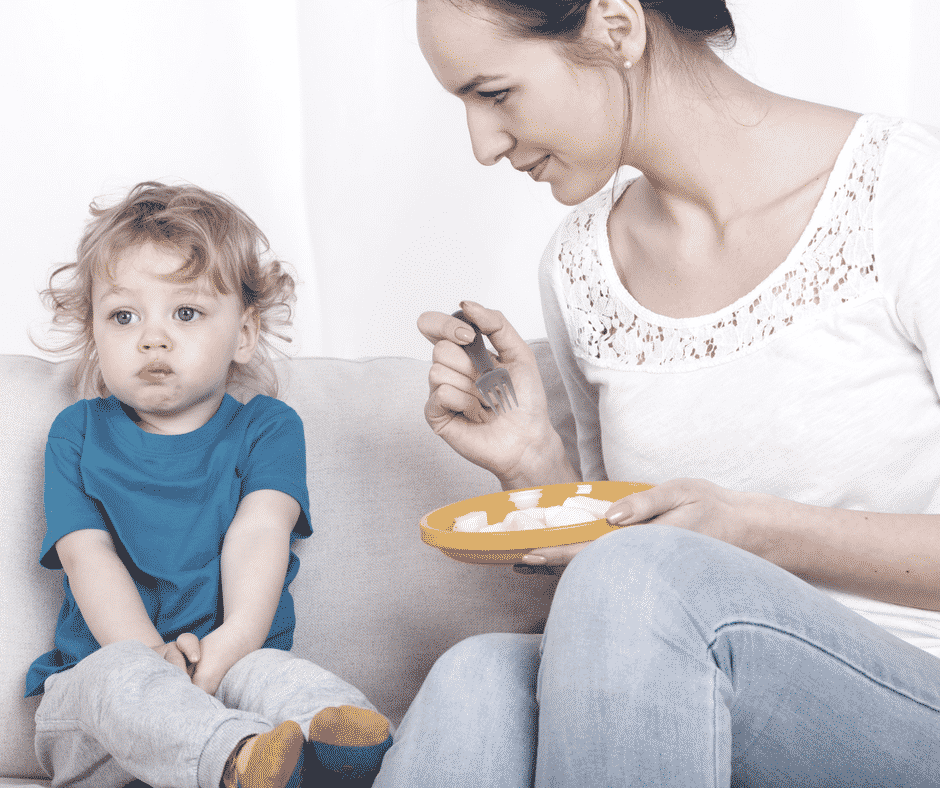Guest Post by Jo Cormack
As parents, we are built to nurture so it’s no wonder we have big feelings when our kids get fussy around dinner. When kids won’t come to the table, won’t eat the food we prepare them, and won’t sit still for a minute, the dream of dinner with everyone connecting at the table flies out of the window.
 Our attempts at nurture have been snubbed.
Our attempts at nurture have been snubbed.
You may feel annoyed, anger, confusion or worry about why your child gets fussy around food, and because those feelings cloud clear thinking, you find yourself resorting to all kinds of methods in a bid to get them to eat.
And when we are stressed it’s easy to turn to bribery, conditions, consequences and punishment. Which hardly brings us closer to the calm, happy mealtimes we desire.
So how can we encourage a child to the table rather than push them away? According to child feeding expert, Jo Cormack, there are many reasons why children might refuse to eat or become fussy eaters, and plenty of good, sensitive solutions to use at mealtimes.
My Child Won’t Eat! Sensitive Solutions for Fussy Eaters, with Jo Cormack
If you are feeling guilty because of your child’s relationship with food, please know that it is not your fault.
What can parents do to relieve the issues they have around fussy eating?
This is a huge question – we are programmed to nurture and feed our children from the day they are born. Or even earlier, if we count pregnancy. When feeding goes awry, this can be disturbing at a very profound level. As parents, our feeling about our children’s eating are coloured by so many things – our beliefs about their health; our aspirations for their eating; our sense of what it is to be a ‘good parent’; our own upbringing; our own relationship with food. This is very complex and deep.
The most common negative emotions I come across in my line of work are anxiety and guilt. If you are anxious about your child’s eating, get them checked out by an appropriate professional then trust them to make their own decisions about what they eat at meals and snacks. This will help them grow in confidence and will build positive associations with eating, which – in the long term – will help them accept new foods.
If you are feeling guilty because of your child’s relationship with food, please know that it is not your fault. There are many genetic factors that influence children’s eating. You only have to look at all the children who are very fussy eaters and yet have a sibling that eats everything. We are all individuals – some children find eating tricky, others love their food. Please don’t blame yourself.
What strategies can you share that work well with kids that have pickier palates?
There are so many tips I could share, but I’ll limit myself to my top three!
- Always include one or two accepted foods with every meal or snack
- Keep on exposing children to a wide variety of foods even if they don’t eat them
- Offer meals and snacks in a consistent and structured way, with no less than two hours between eating opportunities
How can you tell if fussy eating is defiance, preference or something deeper?
Picky eating means different things for different children. To help children move forward, we need to understand what is driving their eating behaviours and this can vary hugely from child to child.
 Rejecting unfamiliar foods and testing boundaries during meals are developmentally normal behaviours for young children. However, if a child is really worried about eating new or disliked foods (I call these children ‘food-anxious’ or ‘anxious eaters’) there may be something more going on.
Rejecting unfamiliar foods and testing boundaries during meals are developmentally normal behaviours for young children. However, if a child is really worried about eating new or disliked foods (I call these children ‘food-anxious’ or ‘anxious eaters’) there may be something more going on.
There are lots of different factors involved in very limited eating and for some children, more than one of these can be in the picture. Some children reject certain foods because they have trouble chewing or swallowing. Some children may be fussy eaters because they find it hard to process the sense data from their food. Sometimes, allergies or digestive problems may contribute to food rejection and in other cases, a child’s temperament may be behind their difficult relationship with food.
In order to get a feeling for whether your child is going through a developmentally normal fussy phase or has more complex eating issues, consider the following:
- How many foods do they eat?
If a child accepts less than fifteen or twenty foods, it’s possible that their limited eating is more than just a stage they are going through.
- Do they reject entire food groups?
This is a sign of more complex eating problems. For example, if a child rejects all meat, they could be finding chewing hard.
- Do their accepted foods share textural qualities?
If a child only eats dry, crunchy foods, for example, their eating issues could have a sensory component.
- Is their food rejection consistent?
If a child eats well at daycare but not at home, if they will eat carrots one day but not the next, perhaps their eating behaviours are more to do with boundary testing and struggles for autonomy or attention.
- Are they truly anxious?
I am a huge believer in parental intuition; if you have a sense that your child is genuinely fearful of trying new or disliked foods, they may have a more complex eating issue, trust your gut!
If you are not sure what is behind your child’s fussy eating and you don’t know whether it is a cause for concern, I always recommend seeking a professional assessment.
How can we set limits on fussy eating in a sensitive way? Should a child be expected to sit at the table and not eat anything, or is it better to let him nibble and the get down as soon as he’s finished?
This depends a bit on the age of the child. I encourage an emphasis on the social side of meals, so I like children to be a part of a meal even if they have chosen not to eat or have had enough. Having said that, I’m not suggesting mealtimes should become a battleground where children are made to sit in silence while the adults eat a long, drawn-out meal.
Let your child know that you expect them to stay at the table while others are eating but limit this to a reasonable timeframe. If they find it hard to do this

or are very young, increase the length of time you expect them to stay at the table, gradually. Perhaps just a minute extra each day (over a few weeks) until they are able to sit for a short while once they have finished.
Equally, use the time to engage your child in a meaningful way. Chat with them and make the meal an opportunity for some positive attention and interaction. This will go a long way towards helping them stay at the table because they will enjoy connecting with you.
In my experience, once a child has learnt to stay at the table while others finish – even though they have had enough to eat – the lack of pressure and focus on them can lead to a small hand reaching out to try a new food while no-one is watching.
Learn more about setting warm limits in this guide
What are some simple things you might say to ease tension at the table?
My number one thing to say would be: “You don’t have to eat it if you don’t want to.” Respecting children’s autonomy and making meals relaxed, positive and pressure-free is what facilitates a good relationship with food.
Is there anything parents shouldn’t do, and why is this?
This might be controversial, but the main thing parents should refrain from doing is encouraging a child to eat. It is culturally normal to believe that our job is to persuade children to eat their food. This is not the case. There is a lot of research evidence that shows that pressure to eat can make picky eating worse. I don’t even recommend insisting children try ‘just one little mouthful’ or that parents use the “No-thank-you-bite,” where children have to try a bite of everything.
Take the focus and pressure off and get on with making meals sociable and enjoyable experiences.
It is super easy to slip into a habit of bribing, distracting or cajoling a child who is not an enthusiastic eater, but try to let them make their own eating decisions. Take the focus and pressure off and get on with making meals sociable and enjoyable experiences.
If you have used the strategy I describe above and have included some accepted foods with each eating opportunity, you can feel confident that you don’t need to offer alternatives if your child chooses not to eat, or eats very little.
To feel good about this approach, you need to know that your child is healthy. If in doubt, book an appointment with their healthcare provider to put your mind at rest.
For more help with fussy eating you might like these posts:
How to use the Hand in Hand tools to Help for Picky Eaters
How Can I Handle My Child’s Picky Eating Without Disrupting the Whole Family?
Picking the Time to Help a Picky Eater
Get this guide to discover 5 Revolutionary Ideas That Make Parenting Less Stressful
Meet Jo Cormack
 Mum of three Jo is a trained counsellor and child feeding expert. Her expertise lies in the emotional, psychological and behavioural aspects of food and feeding. Based in the UK, she assists families and professionals learn how to help children enjoy a varied diet. Her most recent book for professionals working with young children Helping Children Develop a Positive Relationship with Food is out now. You can connect with Jo at emotionallyawarefeeding.co.uk
Mum of three Jo is a trained counsellor and child feeding expert. Her expertise lies in the emotional, psychological and behavioural aspects of food and feeding. Based in the UK, she assists families and professionals learn how to help children enjoy a varied diet. Her most recent book for professionals working with young children Helping Children Develop a Positive Relationship with Food is out now. You can connect with Jo at emotionallyawarefeeding.co.uk



